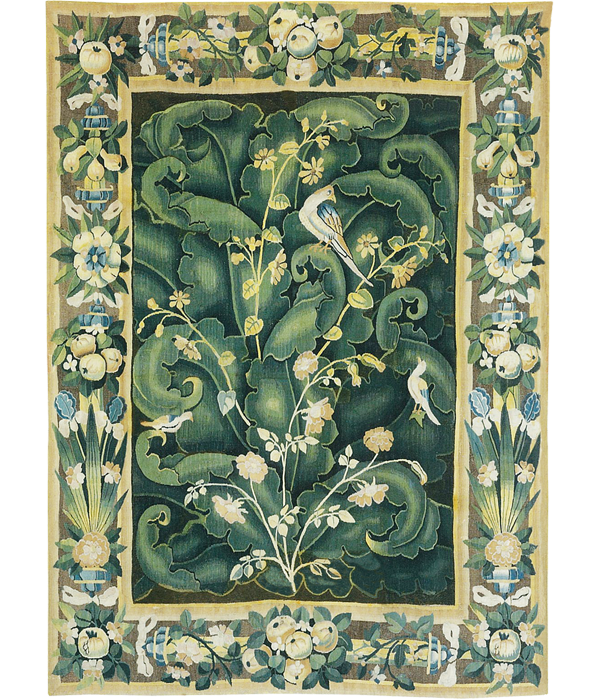An exceptional Flemish Large-Leaf Tapestry
Mid-16th Century, Enghien or Grammont.
Height: 8 ft 7in (262cm) Width: 6ft 2in (190cm)
Woven in wools, depicting various exotic birds perched within scrolling foliage with flowering branches in the foreground, within a ribbon-tied floral border decorated with fruit and flowerheads and a sand-coloured outer slip.
It is certain that centres such as Enghien, Grammont (Geerardsbergen) and Audenarde manufactured large leaf verdure tapestries but it is probable that other cities produced similar works. The identification of specific weaving centres for these tapestries is greatly hindered by the rarity of town marks on the tapestries and insufficient descriptions of the tapestries in 16th Century records.
The design of large curling dentated leaves, verging to a surrealist form, reflected the new naturalism and the study of botany. This was a period when the great botanical gardens were first being developed and new plants were introduced to Europe from Asia and the New World. They were incorrectly described as cabbage leaf or feuilles de choux verdures - in fact they are enlarged acanthus or bear’s breech. The earliest surviving examples are the two armorial hangings woven in 1528 by Henri van Lacke of Enghien for Margaret of Austria that are now in the Iparmuveszeti Museum in Budapest.
A tapestry that has very similar borders and the same thorn-like leaves that are not veined, is in the Museum for Fine Arts, Boston (A Cavallo, Tapestries of Europe and of Colonial Peru in the Museum ofFine Arts, Boston, Boston, 1967, vol. II, pl. 27, and vol. I, cat. 27, p 106-107). These particularities, including the borders that have leaves that do not overlap into the main field and vice versa, allow Cavallo to attribute that tapestry loosely to Enghien and more so to Grammont based on comparable pieces that bear town marks. Two further pieces are in the Austrian State Collection, Vienna, and are illustrated in L. Baldass, Die Wiener Gobelinssammlung, Vienna, 1920, vol. I, pls108 and 106 (bearing the marks of Enghien and Grammont, respectively), while a third bearing the town mark of Grammont is in the Hamburgisches Museum für Kunst und Gewerbe (H. Göbel, Tapestries of the Lowlands, New York, 1924, pl. 471). Another tapestry with very closely related column border enhanced by clusters of flowers and brackets is illustrated in J. Boccara, Ames de Laine et de Soie, Saint-Rémy-en-l' Eau, 1988, p. 69. All the major world museums have examples of these tapestries either fragmented panels or complete examples: The Metropolitan, New York, The Victoria and Albert Museum, London, The Louvre, Paris, The Fine Arts Museum of San Francisco, The Arts Institute of Chicago and the Bayerische National Museum, Munich (with a similar border).
The present tapestry of rare small format, is in good condition, with some minor old repairs, retains original fresh colour, most surviving examples are lacking colour which have faded over time and are in distressed condition, being fragments from larger weavings, this is a rare complete small example. Though five centries old, having surreal tendencies, can be used in modern interior decoration schemes, timeless.
Price : P.O.A.
Share this itemPrint info/picture sheet
Arrange a viewing
Enquire further
